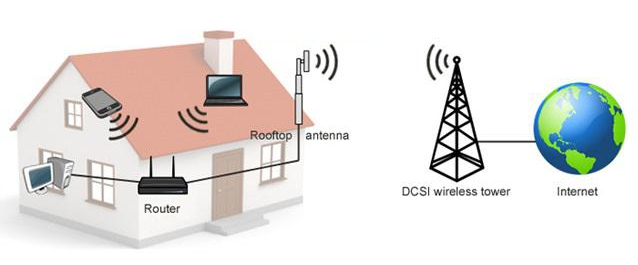In the ever-evolving landscape of telecommunications, the advent of 5G technology has paved the way for groundbreaking innovations, not only in mobile communications but also in the domain of fixed wireless access (FWA). The 5G Fixed Wireless Access market represents a paradigm shift, promising high-speed, reliable, and low-latency connectivity for both residential and business users. This article provides an in-depth exploration of the dynamics surrounding the 5G FWA market, including its historical context, growth drivers, key players, challenges, and the potential impact on the future of broadband connectivity.
- Historical Context: The Evolution of Wireless Technologies
The journey to 5G FWA can be traced back through the annals of wireless communication evolution. From the humble beginnings of 1G, which introduced analog cellular networks in the 1980s, to the subsequent generations – 2G, 3G, and 4G – each iteration brought about significant improvements in data speed, network capacity, and overall performance.
The 4G era marked a turning point with enhanced data rates and the widespread adoption of mobile broadband. However, the insatiable demand for faster and more reliable connectivity paved the way for the development of 5G technology. Recognizing the limitations of traditional fixed-line solutions, the industry began exploring the potential of 5G for fixed wireless access, setting the stage for a transformative era in connectivity.
- The Rise of 5G Fixed Wireless Access:
a. Overview of 5G FWA Technology: 5G FWA represents a departure from conventional fixed-line broadband solutions by leveraging wireless networks to deliver high-speed internet services. This technology harnesses the power of millimeter-wave frequencies, multiple input, multiple output (MIMO) antenna systems, and advanced beamforming techniques to provide gigabit-level speeds with significantly lower latency.
b. Applications and Use Cases: The versatility of 5G FWA opens up a myriad of applications and use cases. From providing last-mile connectivity in urban areas to bridging the digital divide in rural regions, 5G FWA is a game-changer. It also plays a crucial role in supporting emerging technologies such as smart cities, the Internet of Things (IoT), and Industry 4.0.
- Key Market Drivers:
a. Speed and Low Latency: One of the primary drivers propelling the 5G FWA market is the demand for higher data speeds and lower latency. With the ability to deliver gigabit speeds and latency as low as one millisecond, 5G FWA is poised to revolutionize user experiences, particularly in applications like online gaming, virtual reality, and ultra-high-definition video streaming.
b. Flexibility and Accessibility: Unlike traditional fixed-line infrastructure, 5G FWA is inherently flexible and more accessible. The wireless nature of the technology allows for rapid deployment, making it a viable solution for both urban and rural areas. This flexibility is especially advantageous in scenarios requiring quick connectivity, such as disaster recovery or temporary event setups.
c. Smart City Initiatives: As cities worldwide embark on the journey to become smart ecosystems, 5G FWA plays a pivotal role in supporting the connectivity needs of diverse smart city applications. From intelligent traffic management to connected street lighting, the high bandwidth and low latency of 5G FWA facilitate the seamless integration of a multitude of devices and systems.
- Key Players in the 5G FWA Market:
a. Telecom Giants: Established telecommunications giants have been at the forefront of 5G FWA deployment. Companies such as Verizon, AT&T, Deutsche Telekom, and China Mobile possess the extensive infrastructure and global reach necessary to spearhead large-scale 5G FWA rollouts.
b. Technology Providers: Leading technology providers, including Huawei, Ericsson, and Nokia, play a crucial role in shaping the 5G FWA market. Their innovations in hardware, software, and network architecture contribute to the scalability, efficiency, and reliability of 5G FWA solutions.
c. Startups and Regional Players: The 5G FWA market has also witnessed the emergence of startups and regional players keen on capitalizing on niche markets. The agility of these entities allows them to experiment with innovative business models and cater to specific regional needs, contributing to the diversification and competition within the industry.
- Challenges and Concerns:
a. Infrastructure Investment: The deployment of 5G FWA requires substantial investment in infrastructure, including the installation of new base stations and the upgrade of existing networks. This financial commitment can be a significant barrier for some players, particularly in regions with limited resources.
b. Spectrum Allocation: Spectrum allocation is a critical factor in the success of 5G FWA. Regulatory challenges, competition for spectrum bands, and the availability of suitable frequencies can impact the speed and efficiency of deployment. Collaborative efforts between industry stakeholders and regulatory bodies are essential to address these challenges.
c. Security and Privacy Concerns: The advanced nature of 5G FWA technology raises concerns about cybersecurity and user privacy. Securing the vast network of connected devices and ensuring the protection of sensitive data are paramount to building trust among consumers and businesses adopting 5G FWA.
- Global Adoption and Regional Variances:
a. North America: North America has been a frontrunner in 5G FWA adoption, with major telecom operators investing heavily in network infrastructure. The United States, in particular, has seen widespread deployment in urban areas, paving the way for enhanced connectivity experiences.
b. Europe: European countries are also making significant strides in 5G FWA implementation. Regulatory bodies are actively working to allocate spectrum and create an environment conducive to rapid deployment. Trials and collaborations between telecom operators and technology providers are shaping the European 5G FWA landscape.
c. Asia-Pacific: The Asia-Pacific region, home to some of the world’s most populous countries, is witnessing robust growth in 5G FWA adoption. Countries like China are leading the way in large-scale deployments, contributing to the region’s position as a key player in the global 5G FWA market.
d. Latin America, Middle East, and Africa: While challenges such as infrastructure constraints and economic factors may impact the pace of adoption in certain regions, efforts are underway to bridge the digital divide and bring the benefits of 5G FWA to diverse communities.
- Future Outlook:
The future of the 5G FWA market holds tremendous promise as technology continues to evolve and mature. Ongoing research and development efforts are expected to result in further improvements in speed, latency, and coverage. The integration of 5G FWA with emerging technologies such as edge computing, artificial intelligence, and blockchain is poised to unlock new dimensions of innovation and reshape the digital landscape.
- Conclusion:
In conclusion, the 5G Fixed Wireless Access market represents a pivotal moment in the evolution of connectivity, offering a dynamic and high-performance alternative to traditional fixed-line solutions. As the technology continues to mature and global infrastructure expands, 5G FWA is set to revolutionize how individuals and businesses access and experience the digital world. Bridging connectivity gaps, fostering innovation, and unlocking new possibilities, 5G FWA stands at the forefront of the next era in telecommunications, promising a future where seamless, high-speed connectivity is a reality for all.
Read More- Optical Switches Market











